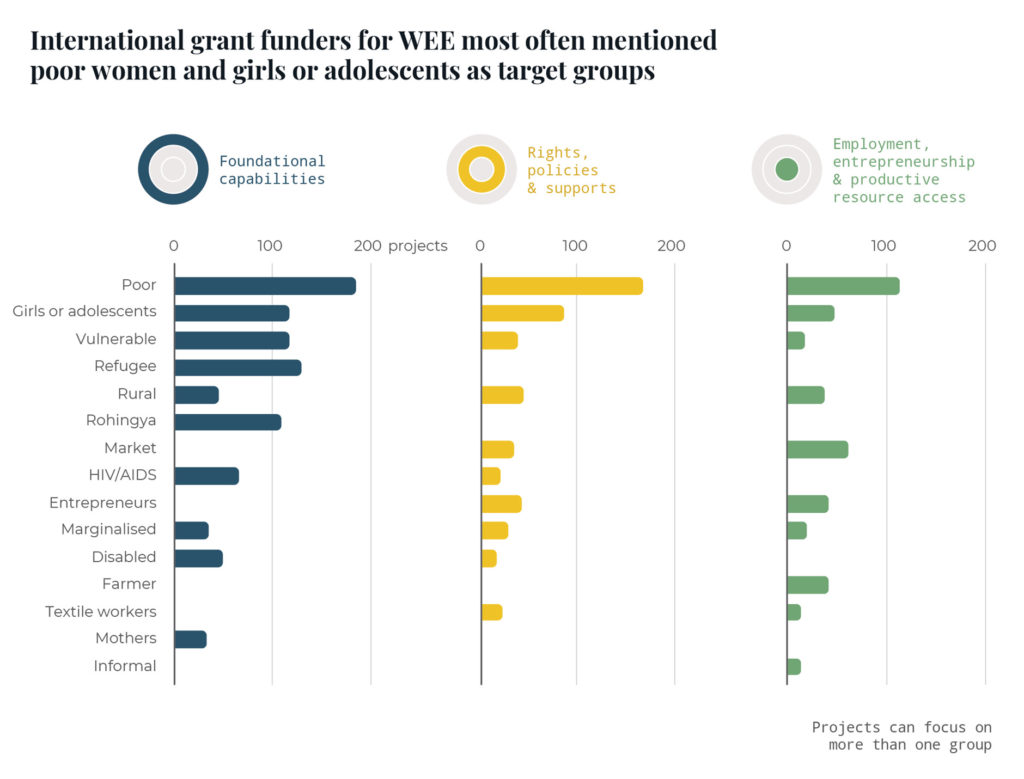Which groups of women are funders supporting?
There is well-established evidence of the numerous and intersecting discriminations women face. Addressing the differential needs of women is complex given that these intersecting discriminations shape economic empowerment and access to resources. Experiences and opportunities differ based on gender identity, race, ethnicity, nationality, migration status, sexuality, class, and caste.
What is less clear is how funding reaches different groups of women and if there are groups not being reached.
In July 2022, Publish What You Fund released new evidence on funding to women’s economic empowerment (WEE) as part of our ‘Women’s Economic Empowerment: building evidence for better investment’ project. Through this project, we have tracked funding for WEE, Women’s Financial Inclusion (WFI), and Women’s Empowerment Collectives (WECs) in three focus countries: Kenya, Nigeria, and Bangladesh. One of the key questions we tried to tackle with this research was ‘who do funders intend to reach with funding for WEE?’.
How we tracked the groups of women supported by funders
As part of our research, we sought to identify which groups of women were specified in international funders’ development assistance funding. We did this using project-level data that includes funding from bilateral, multilateral, and philanthropic donors and development finance institutions. We searched the data using a set list of gender terms such as woman, girl, female, lesbian, and mother to capture a wide initial pool of projects aimed at women. After manually reviewing these projects, using a set of guiding questions, to determine if they did indeed target women’s economic empowerment, we applied a more elaborate list of search terms to help us identify different groups of women funders specified in their program reporting.
Which groups of women are targeted?
We identified an aggregate of 5,647 projects across the three countries. About 65% of these projects mentioned the specific groups of women they aimed to support. The most targeted groups were similar across the three countries. WEE projects mostly targeted girls or adolescent girls and poor and vulnerable women.

We also identified some specific groups unique to the country context. For instance, Bangladesh WEE projects also targeted Rohingya and refugee women. Bangladesh has seen a surge of Rohingya refugees since 2017, with a majority of them being women and children. As we identified in our research, many of them received international funding. For example, one project targeted host communities’ and Rohingya camps’ girls and young women as agents of change and the funding sought to contribute to a protective environment through improved skills and opportunities in the economic market. Nigeria similarly specified internally displaced women for international funding when targeting WEE.
WFI projects mostly targeted women farmers, female entrepreneurs, adolescent girls, young women, and rural women across the three countries. Bangladesh WFI projects also targeted out-of-school girls, child brides, and women and girls with disabilities. Kenya WFI projects also targeted rural and urban slum women. A project in Kenya, for example, aimed to increase financial literacy among young women and girls living in Kibera, an urban slum.
Why do we need to know who funders are targeting?
Identifying the specific groups of women that funding has supported greatly enables the ability to identify gaps in funding. Knowing which groups of women are targeted through international funding provides a starting point for better coordination among international funders and helps to ensure that groups of women on the margins also receive appropriate attention.
From the information provided by funders to the open source platforms we utilised, we can get part of the picture of who funders are trying to reach. However, determining what funding actually reaches these groups of women is still difficult. There are gaps in reporting results data, making impact assessments difficult. Where results data is available, it is often published in attached documents, creating significant accessibility challenges in an undertaking of this scale.
Information on targeted populations is extremely valuable. This is especially true when funding is specifically aimed to help vulnerable populations who often face intersecting discrimination. We applaud the effort by some funders to provide this rich data but call on all funders to publish details on which groups of women their funding aims to support and how they are impacted.
Detailed findings of our work can be accessed here and recommendations to improve donors’ data will be forthcoming later in 2022 in our global transparency report.

